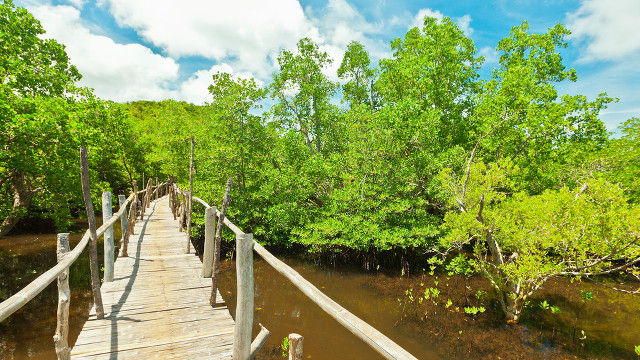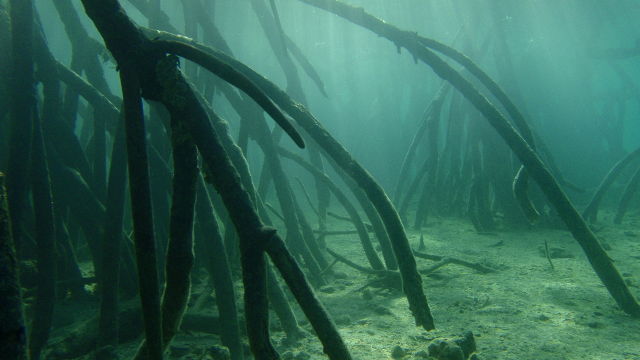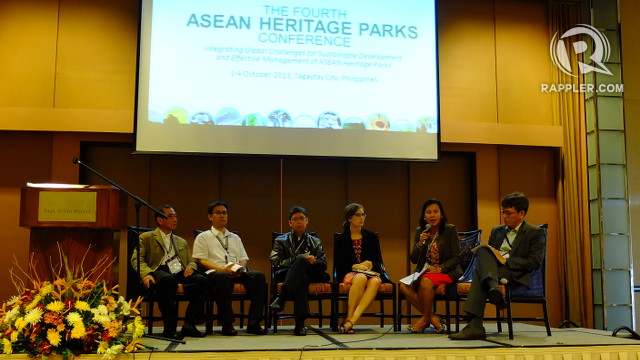SUMMARY
This is AI generated summarization, which may have errors. For context, always refer to the full article.

TAGAYTAY CITY, Philippines – Mangroves are the Philippines’ best hope for mitigating climate change.
While this conclusion was made in panel discussion at the 4th ASEAN Heritage Parks Conference here, an expert said the country’s original 500,000 hectares of mangroves has whittled down to 100,000 hectares or less – no thanks to coastal development, land conversion, and reclamation.
“Mangroves in general are one of nature’s best ways for combatting global warming,” said Filiberto Pollisco, policy and research specialist of ASEAN Centre for Biodiversity (ACB), one of the speakers at a discussion on the relationship between biodiversity and climate change.
The conference was held days after the release of the Fifth Assessment Report by the United Nations Intergovernmental Panel on Climate Change. The report affirmed that human activities cause global warming and warned of higher sea level rise and increased frequency of extreme weather events as “likely” consequences of climate change.
READ: UN climate report: Key points
Mangroves, trees, or shrubs that grow in saline coastal habitats are extremely efficient in sequestering or storing carbon, a base element of greenhouse gases like carbon dioxide.
They store up to 4 times more carbon than tropical rainforests, sequestering 3 to 4 tonnes of carbon per hectare per year. This is equivalent to the carbon emissions of two or 3 vehicles.
In other words, mangroves are crucial in capturing and storing carbon away from the atmosphere, where they would otherwise accumulate and contribute to global warming.
Despite their significance, mangrove forests continue to be threatened by human activity, including the conversion of the forests into fish or shrimp ponds for commercial aquaculture, residential development in coasts, and logging for fuelwood and timber.
Every year for the past 20 years, 628 square kilometers of mangroves in South East Asia were cut down, the highest rate of loss globally.
Adding to the gravity of these alarming figures is the fact that the region’s mangroves have the highest biodiversity. South East Asia is also home to the most number of mangrove species in the world with 47 out of 70 known species present.
In the Philippines, the original 500,000 hectares of mangroves has whittled down to 100,000 hectares or less, said Pollisco, mainly due to coastal development, land conversion and reclamation.
Ticking carbon bomb
But aside from being the country’s best hope against global warming, mangroves are also a ticking carbon time bomb.
When a mangrove forest is uprooted and deforested, the enormous amount of carbon stored in its roots are released into the atmosphere as carbon emissions.
Pollisco reported that digging up only two meters of soil in a mangrove forest for conversion into, say, a shrimp pond, already releases 1,400 tonnes of carbon per hectare per year.
Carbon emissions from mangrove deforestation accounts for up to 10% of emissions from tropical rainforest deforestation despite the fact that total area of mangroves is only 0.7% that of tropical rainforest area worldwide.

If this is not enough to discourage uprooting of mangrove sanctuaries, Pollisco cited more benefits of mangrove areas to communities on the frontline of the the worst climate change impacts.
Mangrove forests act as barriers or natural seawalls that protect coastal communities from tsunamis and storm surges, phenomena which are now more common because of climate change.
This was proven when satellite images of Aceh, Indonesia, after the 2004 earthquake-induced tsunami showed that coastal communities with mangroves suffered less damages compared to communities without mangroves.
The mangroves also act as a buffer for sea level rise, a phenomenon also linked to climate change. Sea levels rise by two to 3 centimeters every year, said Pollisco, but communities don’t feel it because mangroves stop the water from encroaching upon them.
“Locals just wake up one day and find the mangroves at their doorstep because they have moved landwards to avoid being drowned by sea level rise,” he said.
Pockets of conservation
In terms of legislating protection for mangroves, however, the Philippine government is in the right direction.
“Right now they’re in the right direction by coming up with policies to ban cutting or converting mangroves into other uses. Unfortunately, it’s not happening. You hear a lot about coastal reclamation where mangroves are cut. Manila Bay used to have more mangrove forests,” said Pollisco.
Fortunately, there are still a few preserved mangrove sanctuaries such as the Las Piñas-Parañaque Critical Habitat and Ecotourism Area (LLCHEA), the first critical habitat established in the country and a favorite destination of birdwatchers who revel in the area’s rich biodiversity.
But Pollisco worries that even these few remaining areas are at risk from pending commercial development and reclamation plans.
In other parts of the Philippines, local government units have taken the initiative to safeguard their mangroves. The Banacon Island Mangrove Forest in Bohol and the Baliangao Protected Landscape and Seascape in Misamis Occidental benefit from ecotourism programs in which locals earn from activities like snorkeling, boating, scuba-diving and birdwatching, activities made possible by the presence of the mangrove sanctuaries.
In surfing hotspot Siargao, the local government has committed to rehabilitating and protecting the mangrove forests that can shelter them from tsunamis, to which the island is highly vulnerable, according to Climate Change Commission Secretary Lucille Sering.
READ: Are we ready for another Ondoy?
But it will take more than pockets of conservation for the Philippines to make the most of the climate-change-mitigating potential of mangroves, concluded participants of the discussion.
More collaboration and coordination between local, national governments, and international bodies is needed to keep this best hope alive. – Rappler.com
Bohol mangroves image from Shutterstock
Mangrove roots image from Shutterstock
Add a comment
How does this make you feel?

There are no comments yet. Add your comment to start the conversation.